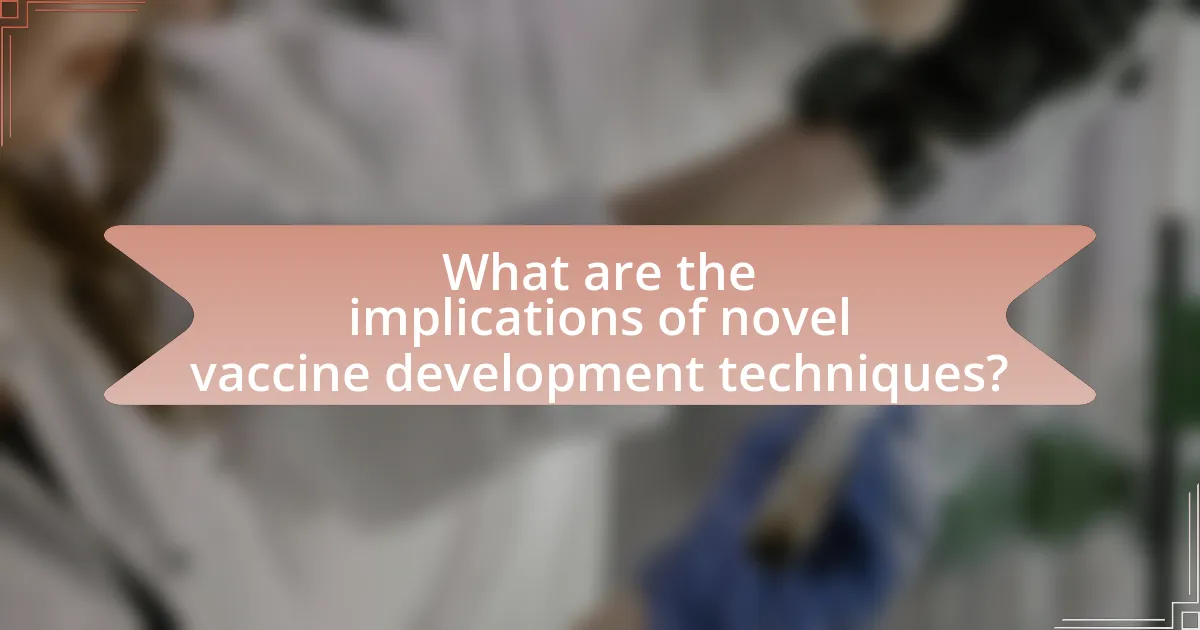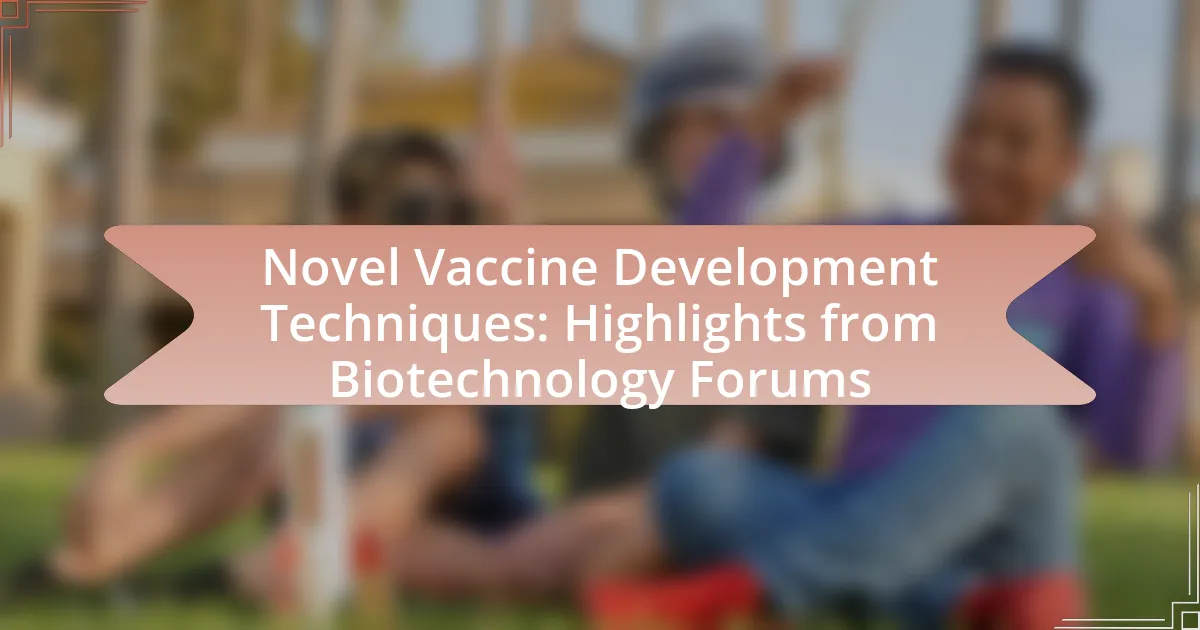Novel vaccine development techniques encompass advanced methodologies such as mRNA vaccines, viral vector vaccines, and protein subunit vaccines, which significantly enhance immune responses and vaccine efficacy. This article highlights the differences between these novel approaches and traditional vaccine development, emphasizing their rapid production capabilities and innovative technologies. Key innovations, including mRNA technology and nanoparticle-based vaccines, are discussed in relation to their impact on vaccine efficacy and public health. Additionally, the article addresses the importance of these techniques in pandemic preparedness, global health challenges, and the role of biotechnology forums in advancing vaccine research and development.

What are Novel Vaccine Development Techniques?
Novel vaccine development techniques include mRNA vaccines, viral vector vaccines, and protein subunit vaccines. These methods leverage advanced biotechnology to enhance immune responses and improve vaccine efficacy. For instance, mRNA vaccines, such as those developed for COVID-19, utilize synthetic messenger RNA to instruct cells to produce a viral protein, prompting an immune response without using live virus. This approach has been validated by the rapid development and deployment of the Pfizer-BioNTech and Moderna vaccines, which demonstrated over 90% efficacy in clinical trials. Additionally, viral vector vaccines, like the Johnson & Johnson vaccine, use a harmless virus to deliver genetic material from the target pathogen, further showcasing the versatility and effectiveness of novel vaccine technologies.
How do these techniques differ from traditional vaccine development?
Novel vaccine development techniques differ from traditional vaccine development primarily in their speed and methodology. Traditional vaccine development often involves using weakened or inactivated pathogens, which can take years to produce and test for safety and efficacy. In contrast, novel techniques, such as mRNA and viral vector vaccines, utilize genetic information to instruct cells to produce antigens, significantly reducing development time. For example, the mRNA vaccines for COVID-19 were developed and authorized for emergency use within a year, showcasing the rapid capabilities of these modern approaches compared to the typical decade-long timeline for traditional vaccines.
What are the key innovations in novel vaccine development?
Key innovations in novel vaccine development include mRNA technology, viral vector platforms, and nanoparticle-based vaccines. mRNA vaccines, such as those developed for COVID-19 by Pfizer-BioNTech and Moderna, utilize synthetic messenger RNA to instruct cells to produce a protein that triggers an immune response, demonstrating rapid development and high efficacy. Viral vector platforms, like the Johnson & Johnson vaccine, use harmless viruses to deliver genetic material from the target pathogen, enhancing immune recognition. Nanoparticle-based vaccines, which encapsulate antigens in nanoparticles, improve stability and immune response, as seen in research by the National Institutes of Health. These innovations represent significant advancements in vaccine technology, enabling quicker responses to emerging infectious diseases.
How do these innovations impact vaccine efficacy?
Innovations in vaccine development techniques significantly enhance vaccine efficacy by improving the precision and speed of vaccine design and production. For instance, mRNA technology allows for rapid adaptation to emerging pathogens, as seen in the COVID-19 vaccines, which demonstrated over 90% efficacy in preventing severe disease. Additionally, novel adjuvants can boost immune responses, leading to longer-lasting immunity. Research indicates that vaccines utilizing these advanced methods can achieve higher antibody titers and broader immune responses compared to traditional approaches, thereby increasing overall effectiveness against various strains of pathogens.
Why is the development of novel vaccines important?
The development of novel vaccines is important because it enhances public health by providing effective prevention against emerging infectious diseases. Novel vaccines can target pathogens that current vaccines do not adequately protect against, such as newly identified viruses or antibiotic-resistant bacteria. For instance, the rapid development of mRNA vaccines during the COVID-19 pandemic demonstrated the ability to quickly respond to a global health crisis, showcasing the potential of innovative vaccine technologies to save lives and reduce healthcare burdens. Additionally, novel vaccines can improve immunogenicity and safety profiles, leading to broader population coverage and better control of disease outbreaks.
What global health challenges do novel vaccines address?
Novel vaccines address global health challenges such as infectious diseases, emerging pathogens, and vaccine-preventable illnesses. For instance, vaccines targeting diseases like COVID-19, influenza, and human papillomavirus (HPV) have been developed to combat widespread outbreaks and reduce morbidity and mortality rates. The World Health Organization reports that vaccines prevent 2-3 million deaths annually from diseases like measles and diphtheria, highlighting their critical role in public health. Additionally, novel vaccines are being designed to tackle antibiotic resistance and enhance immune responses against chronic diseases, further demonstrating their importance in addressing contemporary health challenges.
How do novel vaccines contribute to pandemic preparedness?
Novel vaccines enhance pandemic preparedness by enabling rapid development and deployment in response to emerging infectious diseases. These vaccines utilize advanced technologies, such as mRNA and viral vector platforms, which allow for quicker design and production compared to traditional methods. For instance, the mRNA vaccines developed for COVID-19 were created and authorized for emergency use within a year of the virus’s identification, demonstrating the agility of novel vaccine technologies. This rapid response capability is crucial for controlling outbreaks and minimizing public health impacts, as evidenced by the swift vaccination campaigns that significantly reduced transmission rates during the pandemic.

What are the latest highlights from Biotechnology Forums on vaccine development?
Recent highlights from Biotechnology Forums on vaccine development include advancements in mRNA technology, which have shown promise in rapid vaccine production and adaptability to emerging pathogens. Additionally, discussions emphasized the role of nanoparticle-based delivery systems that enhance immune responses and stability of vaccines. Notably, the forums showcased collaborative efforts between biotech companies and academic institutions, leading to innovative approaches in vaccine design and testing protocols. These developments are supported by data indicating increased efficacy and safety profiles in clinical trials, reinforcing the potential of these novel techniques in addressing global health challenges.
What topics are frequently discussed in these forums?
Topics frequently discussed in biotechnology forums include advancements in mRNA vaccine technology, the use of viral vectors for vaccine delivery, and the development of adjuvants to enhance immune responses. These discussions often highlight recent research findings, regulatory challenges, and collaborative efforts in vaccine development. For instance, the rapid development of COVID-19 vaccines has spurred conversations around the efficacy and safety of novel platforms, as evidenced by the widespread sharing of data from clinical trials and peer-reviewed studies.
Which novel techniques have gained the most attention recently?
mRNA vaccine technology has gained the most attention recently in novel vaccine development techniques. This approach, exemplified by the Pfizer-BioNTech and Moderna COVID-19 vaccines, utilizes messenger RNA to instruct cells to produce a protein that triggers an immune response. The success of these vaccines has led to increased investment and research into mRNA technology for other infectious diseases and cancer therapies, highlighting its potential for rapid development and adaptability.
How do experts evaluate the effectiveness of these techniques?
Experts evaluate the effectiveness of novel vaccine development techniques through rigorous clinical trials, statistical analysis, and peer-reviewed studies. Clinical trials assess safety and efficacy by comparing the immune response and protection levels in vaccinated groups against control groups. Statistical analysis, including metrics like efficacy rates and confidence intervals, provides quantifiable evidence of a technique’s performance. Peer-reviewed studies further validate findings by ensuring that methodologies and results meet scientific standards, as seen in publications like “The Lancet” and “Nature Biotechnology,” which often report on advancements and evaluations in vaccine technologies.
Who are the key speakers and contributors in these forums?
The key speakers and contributors in the biotechnology forums focused on novel vaccine development techniques include leading researchers, industry experts, and academic professionals. Notable figures often featured are Dr. Anthony Fauci, who has extensive experience in infectious diseases and vaccine research, and Dr. Katalin Karikó, known for her pioneering work on mRNA technology. Additionally, representatives from major pharmaceutical companies, such as Pfizer and Moderna, frequently participate to share insights on vaccine innovation and development processes. These contributors provide valuable perspectives based on their research and practical experiences in the field, enhancing the discussions around vaccine advancements.
What insights do industry leaders provide on vaccine innovation?
Industry leaders emphasize the importance of mRNA technology as a transformative approach in vaccine innovation. This technology, exemplified by the rapid development of COVID-19 vaccines, allows for quicker responses to emerging pathogens by enabling the production of vaccines that can be tailored to specific viruses. Additionally, leaders highlight the significance of collaboration between public and private sectors, which accelerates research and development processes. For instance, partnerships during the COVID-19 pandemic led to unprecedented vaccine development timelines, showcasing the effectiveness of shared resources and expertise. Furthermore, industry experts advocate for continuous investment in vaccine research to address global health challenges, as evidenced by the increased funding for vaccine initiatives post-pandemic.
How do academic researchers contribute to the discussions?
Academic researchers contribute to discussions by providing evidence-based insights and innovative perspectives on vaccine development techniques. Their expertise allows them to analyze data, share findings from clinical trials, and discuss emerging technologies, such as mRNA and viral vector platforms. For instance, researchers from institutions like the University of Oxford have played a crucial role in advancing the understanding of vaccine efficacy and safety, particularly during the COVID-19 pandemic. Their contributions are essential for informing policy decisions and guiding future research directions in biotechnology forums.

What are the implications of novel vaccine development techniques?
Novel vaccine development techniques significantly enhance the speed and efficacy of vaccine production, leading to quicker responses to emerging infectious diseases. For instance, mRNA vaccine technology, exemplified by the Pfizer-BioNTech and Moderna COVID-19 vaccines, allows for rapid design and manufacturing, enabling vaccines to be developed in a matter of weeks rather than years. This was evidenced during the COVID-19 pandemic, where mRNA vaccines were authorized for emergency use within a year of the virus’s identification, showcasing a paradigm shift in vaccine development timelines. Additionally, these techniques can improve vaccine safety profiles and efficacy by allowing for more precise targeting of pathogens, as seen in the use of viral vector platforms. Overall, the implications of these advancements include not only faster vaccine availability but also the potential for broader applications in combating various diseases, thereby transforming public health strategies globally.
How do these techniques affect public health policies?
Novel vaccine development techniques significantly influence public health policies by enabling faster and more effective responses to emerging infectious diseases. These advancements allow for the rapid design and production of vaccines, which can be crucial during outbreaks, as evidenced by the swift development of COVID-19 vaccines using mRNA technology. This capability leads to updated vaccination strategies and policies that prioritize rapid deployment and accessibility, ultimately improving population immunity and reducing disease transmission rates. Furthermore, the integration of these techniques into public health frameworks can enhance surveillance and preparedness, ensuring that health systems are better equipped to handle future health crises.
What role do regulatory agencies play in the approval of novel vaccines?
Regulatory agencies are responsible for ensuring the safety, efficacy, and quality of novel vaccines before they are approved for public use. These agencies, such as the U.S. Food and Drug Administration (FDA) and the European Medicines Agency (EMA), evaluate clinical trial data, manufacturing processes, and labeling to confirm that vaccines meet established standards. For instance, the FDA requires a series of preclinical and clinical trials, including Phase I, II, and III studies, to assess a vaccine’s safety and effectiveness in diverse populations. This rigorous review process is crucial, as evidenced by the rapid yet thorough evaluation of COVID-19 vaccines, which were authorized under Emergency Use Authorizations after demonstrating significant efficacy and safety profiles in large-scale trials.
How can these techniques influence vaccine accessibility and distribution?
Novel vaccine development techniques can significantly enhance vaccine accessibility and distribution by streamlining production processes and improving delivery methods. For instance, mRNA technology allows for rapid vaccine development, enabling quicker responses to emerging infectious diseases, as demonstrated during the COVID-19 pandemic where mRNA vaccines were developed and distributed within months. Additionally, advancements in cold chain logistics, such as the use of thermostable vaccines, facilitate easier transportation and storage, particularly in low-resource settings. These innovations collectively contribute to broader vaccine reach and timely immunization efforts, ultimately improving public health outcomes.
What challenges are associated with novel vaccine development?
Novel vaccine development faces several challenges, including scientific, regulatory, and logistical hurdles. Scientific challenges involve the complexity of understanding pathogen biology and immune responses, which can delay the identification of effective vaccine candidates. Regulatory challenges arise from the need to meet stringent safety and efficacy standards set by health authorities, often requiring extensive clinical trials that can be time-consuming and costly. Logistical challenges include the need for advanced manufacturing capabilities and distribution networks, particularly for vaccines requiring cold chain storage, as seen with mRNA vaccines during the COVID-19 pandemic. These factors collectively contribute to the difficulties in bringing novel vaccines to market efficiently.
What are the common obstacles faced during the research phase?
Common obstacles faced during the research phase include limited funding, regulatory hurdles, and access to necessary resources. Limited funding restricts the scope and scale of research projects, often leading to incomplete studies or the inability to pursue innovative approaches. Regulatory hurdles can delay the research process, as compliance with safety and efficacy standards is mandatory before advancing to clinical trials. Additionally, access to necessary resources, such as specialized equipment or expert personnel, can hinder progress, particularly in novel vaccine development where cutting-edge techniques are essential. These challenges are frequently discussed in biotechnology forums, highlighting their impact on the pace of vaccine innovation.
How can these challenges be overcome in future developments?
Future developments in novel vaccine techniques can overcome challenges by integrating advanced technologies such as mRNA platforms and AI-driven predictive models. These technologies enhance the speed and efficiency of vaccine design and testing, as evidenced by the rapid development of COVID-19 vaccines, which utilized mRNA technology to achieve efficacy in record time. Additionally, fostering collaboration between academia, industry, and regulatory bodies can streamline the approval process and facilitate knowledge sharing, thereby addressing logistical and regulatory hurdles. The success of initiatives like the Coalition for Epidemic Preparedness Innovations (CEPI) demonstrates the effectiveness of collaborative frameworks in accelerating vaccine development.
What best practices can be adopted for successful vaccine development?
Successful vaccine development can be achieved by adopting best practices such as rigorous preclinical testing, robust clinical trial design, and continuous monitoring of safety and efficacy. Rigorous preclinical testing ensures that vaccine candidates are evaluated for immunogenicity and safety before human trials, which is critical for identifying potential issues early. Robust clinical trial design, including randomized controlled trials, helps to generate reliable data on vaccine effectiveness and safety across diverse populations. Continuous monitoring of safety and efficacy during and after trials, often through pharmacovigilance systems, ensures that any adverse effects are promptly identified and addressed. These practices are supported by historical successes in vaccine development, such as the rapid development of mRNA vaccines for COVID-19, which utilized these principles to achieve high efficacy and safety profiles.


